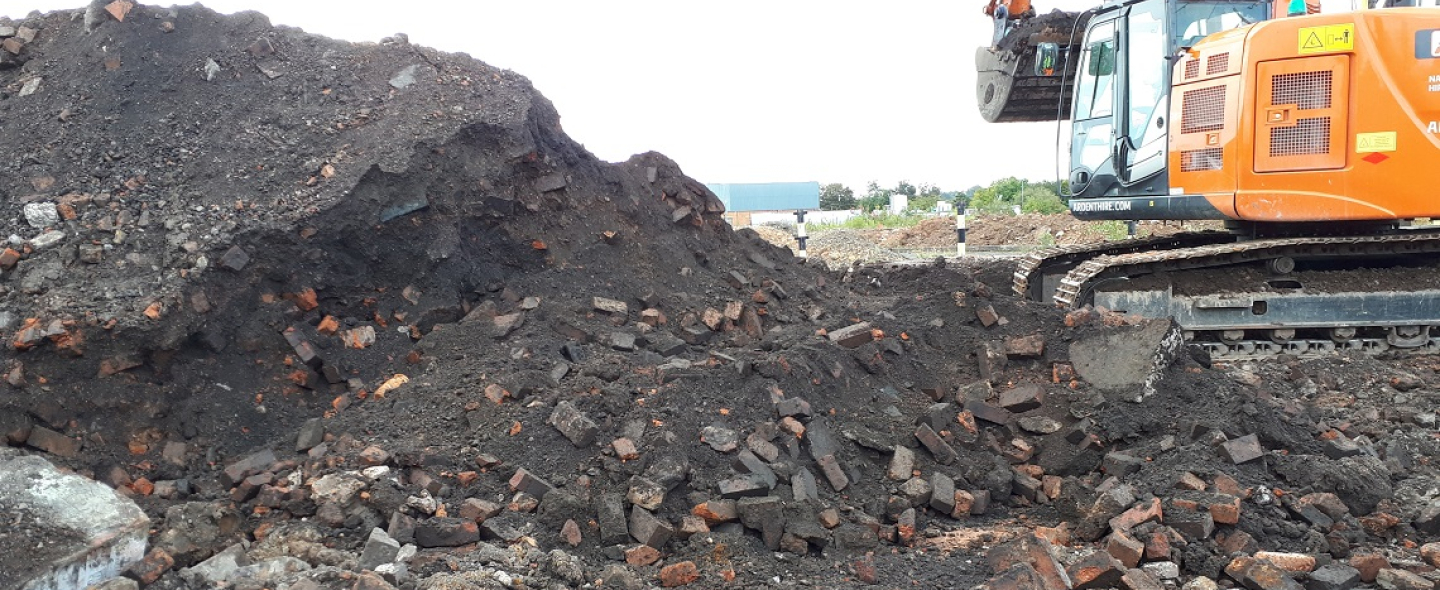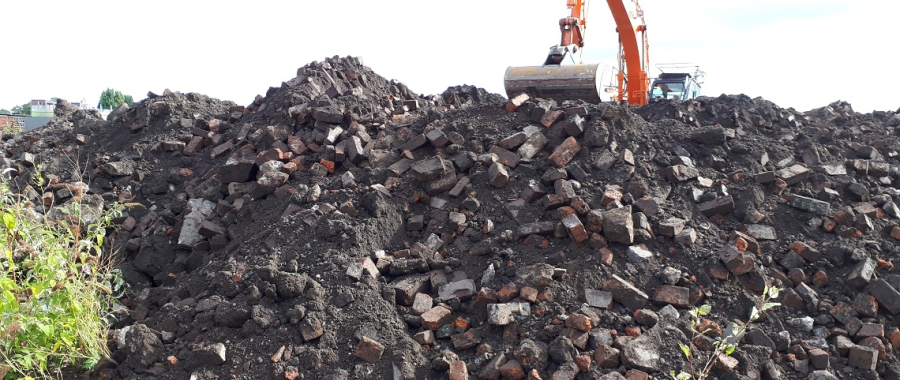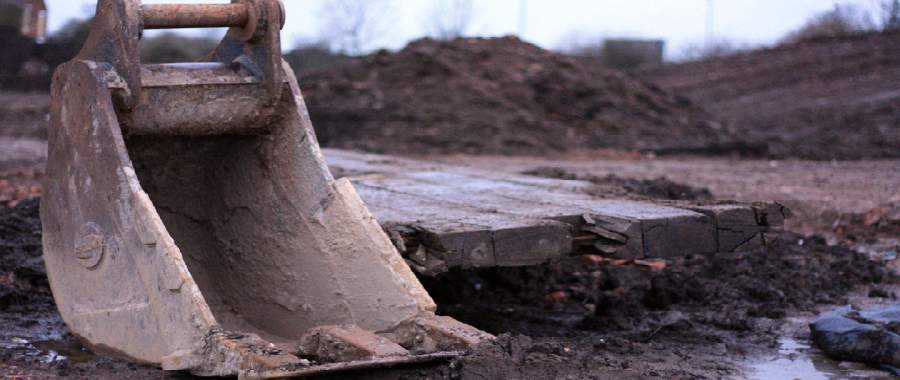
Excavating in Potentially Asbestos-Contaminated Ground – FAQs from Contractors
Although asbestos is a big problem when working on many brownfield sites, proper planning and management of these risks can lead to the successful delivery of projects without unnecessary delays or unexpected surprises partway through the works.
Many brownfield development projects involve excavations and landscaping work in ground that has been affected by previous site uses. Made ground is commonly present, and this often consists of historical demolition materials and other wastes deposited during previous site works. Due to poor practices in the past, asbestos fibres and/or pieces of asbestos-containing construction materials are commonly part of the make-up of such made ground, and therefore contractors are faced with a significant risk when dealing with it.
Although asbestos is a big problem when working on many brownfield sites, proper planning and management of these risks can lead to the successful delivery of projects without unnecessary delays or unexpected surprises partway through the works. Some of the common issues and questions that contractors involved in earthworks and landscaping ask are covered below.
Asbestos Contaminated Ground FAQs
The most common source of asbestos in the ground is the historical burying of demolition materials, so all forms of asbestos-containing materials (ACM) used in buildings may be present. These are numerous, with some being more recognisable as containing asbestos than others. By far the most common ACMs encountered are pieces of asbestos cement used in building roofs and walls, while asbestos insulating board and asbestos lagging are also fairly frequently encountered. Less obvious ACM materials can be coatings such as Artex, some types of floor tiles, paper, felt and cardboard.
The amount of ACM and size of the pieces can vary significantly due to the extent of to which the material has been broken up before burying. It is more common to encounter relatively small ACM fragments/clumps of fibrous material, but large caches of deliberately buried larger ACM pieces (such as whole roof panels) are sometimes found.
It is often the case that no ACM has been seen in the made ground on site, but laboratory testing of samples still detects a significant amount of asbestos. This can be due to the ACM pieces being coated in soil or as a result of deterioration, leading to free asbestos fibres which are invisible to the naked eye. This demonstrates the importance of an effective site investigation, including testing for asbestos on relevant sites.
The health risks from asbestos are well documented, with the most common related illness being various forms of lung cancer, the symptoms of which are presented many years after exposure. Asbestos still kills around 5000 workers each year, this is more than the number of people killed on the road. However, in order for there to be a health risk from asbestos, it is necessary for a person to inhale asbestos fibres. All asbestos carries a significant risk, but some types of asbestos fibres (e.g. blue or brown asbestos) have more potential to cause lung damage than others, such as white asbestos.
Handling ACMs and soil containing asbestos fibres during groundworks gives rise to significant disturbance compared to a site with buried asbestos in ‘normal’ use. This is particularly the case when moving material by machine, processing it with techniques such as crushing and screening and in dry and dusty conditions.
It should be noted that a number of contaminated land investigation reports and remediation strategies do not effectively cover asbestos risks due to either a lack of asbestos experience or a lack of PI insurance cover for asbestos advice held by the author (or both). When provided with works information, it is therefore important to question whether asbestos risks have been fully considered.
Due to the significant health risks, employers have additional legal responsibilities, over and above other health and safety law, towards employees who are potentially working with asbestos. The overarching legislation applied is the Control of Asbestos Regulations 2012 (CAR 2012) and the HSE has produced an Approved Code of Practice (ACoP) for working with asbestos.
Furthermore, a relatively recent joint industry working group guidance document known as CAR-SOIL has been produced, which provides a definitive explanation of how the legal requirements of CAR 2012 have been interpreted to apply to those working with asbestos-contaminated soil and construction and demolition materials. Therefore, apart from the significant health risks, there is a robust legal framework regulated by the HSE that sets out the responsibilities of those working with ground that is potentially contaminated with asbestos. This means that contractors that do not properly consider and manage the risks have a higher potential for prosecution and reputational damage.
Any disturbance of ACMs and asbestos-containing soils will present a risk, but the extent of the dangers posed can vary significantly based on what materials are being disturbed and the level of disturbance. As a rule of thumb, the more degraded and friable (crumbly) the ACM and the more aggressive the site handling, the more risk there is of fibres becoming airborne.
Listed below are types of ACM products ranked in order of the risk of airborne fibre release (lowest risk first):
Asbestos cement
Broken asbestos cement
Textiles
Hard set lagging
Asbestos insulating board
Loose insulation
Site activities that lead to the risk of the breaking up of materials or the release of dust are far more likely to lead to airborne fibres, so some of the higher risk activities include crushing, screening, riddling, tipping of loads, piling (apart from driven piles) and soil mixing. However, any activities that may give rise to dust generation (including windblown dust) from the ground surface and stockpiles present a risk when ACMs and free fibres are present.
Asbestos in the ground presents a further risk in relation to waste disposal, as even small amounts of visually identifiable ACMs in otherwise clean soil will mean that the soil cannot be disposed of as non-hazardous waste.
There are a range of control measures that SOCOTEC recommends depending on the site-specific circumstances. The main elements of risk management should include:
A proper understanding of the potential for asbestos to be present, the likely types of ACM, amounts and distribution. This is usually informed via site investigation
A fully developed risk assessment and risk management plan to set out the dangers and control measures required in specific areas of the site and by specific personnel (plan of works)
Site zoning, restricting access and setting higher level control measures in higher risk areas
An understanding of any regulatory requirements to notify the HSE and/or procure a licensed subcontractor
Dust control measures, including dust suppression
An effective watching brief to quickly identify potential ACMs during excavations
Good site hygiene by all staff
Provision of specific PPE (personal protective equipment) and sometimes RPE (respiratory protective equipment) to relevant staff with effective training and fitting
Effective training of all staff (asbestos awareness), with staff involved directly in works that will encounter ACMs having additional non-licensed work training.
Air monitoring for reassurance and control purposes
Where necessary, employment of specially licensed asbestos subcontractors
Emergency and contingency plans for dealing with larger volumes of ACMs should they be encountered
Ongoing testing of materials, especially for waste classification, and correct classification of wastes in line with waste legislation
SOCOTEC can provide site specific risk assessments and asbestos management plans to enable contractors to effectively manage and comply with risks in a practical way.
Many development projects on brownfield sites are carried out in accordance with an approved site-specific remediation strategy, which allows some contaminated materials to be reused or retained on site in locations that will not present a risk in the long-term. This often means that ACMs may be able to be retained on site beneath a clean cover system or hard surface.
A significant amount of assessment, documentation, verification and third party approvals are required when contaminated material is proposed to be retained on site, and the most common regulatory route to use is the Definition of Waste Code of Practice. As a result, a contractor considering the retention of some ACMs on site must seek appropriate advice and allow for adequate time and budgets to go through the formal process. The implications of burying asbestos contamination on site without having gone through the proper regulatory approvals or implementing the necessary site management controls and verification are serious, and could lead to potential prosecution and significant landfill tax liabilities.
Work with asbestos generally falls under one of the following three categories: non-licensed work, notifiable non-licensed work and licensed work, with the latter two categories requiring the HSE to be notified in advance of the works. The category of work depends on the site-specific circumstances and is generally assessed as part of the Asbestos Management Plan, taking into consideration CAR-SOIL. In the case of works being licensed, the HSE notification must be at least 14 days prior to the commencement of works. All notifiable activities will also require the relevant staff to undergo medical examinations.
It is often advisable to keep neighbouring sites, the local authority, clients and other stakeholders well informed of any scheduled works, as this will allow them to manage their own risks as appropriate and also provide confidence that the risk is being properly managed. On brownfield development sites, the local authority is likely to have imposed contaminated land planning conditions and other stipulations, so they may also be required to formally approve the plans prior to commencement.
It is imperative that all staff and visitors are aware of the risks, control measures and their own responsibilities, and this should be achieved via effective training, inductions and toolbox talks. If excavated materials are to be reused on site, a materials management plan is likely to be needed, requiring notifications to the Environment Agency and other bodies.
The need for air monitoring will be defined within the asbestos management plan, and it is normal for at least some airborne fibre monitoring to be undertaken during key stages of work. Data which demonstrates that legal control limits have not been exceeded will provide reassurance to all stakeholders, as well as a defence should any claim of exposure arise.
Monitoring can be carried out in the work area, on site boundaries, at nearby sensitive off site locations or even by personally monitoring specific employees. Work area monitoring is the most common, and this is normally carried out over a single shift (although short-term monitoring is possible).
It is important to keep records demonstrating compliance with CAR-SOIL and the asbestos management plan, which includes the plan itself, training records, medical records (where required), monitoring results, records of site activities and documentation of any changes to the original plan of works. All waste duty of care and consignment notes will need to be retained in order to comply with waste legislation.
Depending on the site-specific remediation design, records of compliance with the remediation strategy may well also be required. This would commonly entail analysis data and proof of the installation of cover systems and so on. If a materials management plan is involved, further materials volume and tracking records will be needed.


